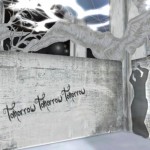Posts tagged safety
Thoughts on Student Safety and Using OpenSim for Education
1OpenSim is making headway as a viable alternative to Second Life. About 98% of the functionality of Second Life is present in OpenSim. The remaining 2% primarily deals with vehicle physics. Although it is still considered “alpha” software, OpenSim hosting is sold, and teachers, students, and businesses are taking advantage. The alpha status reflects more on the rapidly changing nature of the virtual world market, than the stability of the software itself. Microsoft and IBM have some backing in it. Intel operates its ScienceSim experiments with OpenSim, and has made headway in providing models for ubiquitous shareable content and massive user connections.
There are definitely some measures being taken to address educators’ needs. The Jokaydia and 3rd Rock Grids have been around for several years, and they are largely education-oriented. Last year, Firesabre launched its own Starlight Grid, which provides private hosting for educators. And Kitely is starting to establish itself as the premiere third-party choice for educators, and provides the option for making user-created regions private. However, as hypergridding becomes more stable and common, this can be the vehicle to unite different grids into a single education-related hypergrid. The common “education hypergrid” should blend the most relevant content for students and teachers into a singularly accessible virtual space. There should never be any reason for a teacher or student to log out of their viewer and log back into another grid with a whole new avatar. But we need to think about how to make such a hypergrid suitable for students, especially K-12 since there’s often a litany of additional laws and policies governing online interactions and access for them.
A few thoughts and ideas come to mind:
- It is more productive to include students rather than solely use teachers to create content. Many teachers already do this, since with their often beyond-full-time jobs they simply don’t have the time to both learn the skills needed for building in a virtual world, and actually construct the content alone. We should use the skills of the young tech-savvy generation, and develop constructionist class projects that appeal to our students.
- Activities should directly tie in with the curriculum. This is rather obvious, but it would be useful if virtual world activities were tagged with the relevant standards and/or objectives they address. This way, others in the same state, province, or country can find relevant material, without having to wonder if it actually addresses the necessary learning content or is just another topical sim.
- To address safety issues, different approaches have been taken. I mentioned above how FireSabre and Kitely provide private regions. For educators, they don’t want inappropriate content to drift in, or outside trolls to visit the region and cause havoc while students are using it. While securing a sim for exclusive private access is well-intentioned, they miss out on the community-produced educational content. Whether this is on Second Life, OSGrid, or any other virtual world system, a significant strength of the virtual world is in its shared content. We should avoid having to recreate the wheel each time.
- One solution could be to script a session monitor. Those who wish to join the education hypergrid can be required to place a script inside each region which connects to a server and monitors participants. Teachers who wish to use a particular region (or group of regions) for learning but are worried about others coming in and disrupting the class can reserve a session, and either enter their students’ avatar names, or have the students sign up themselves. The script would monitor anyone entering or currently in the region and kick out anyone not registered for the session. A publicly viewable calendar in the regions and on the web would let others know what time slots are open.
- We need to provide a venue for coordinating with educators and organizations who are considering investing actual time or money in the development of a sim. If similar goals and objectives can be identified, pooling resources together may help alleviate the burden for all parties involved.
-

Regions such as the "Foul Whisperings, Strange Matters" Macbeth sim in Second Life could be added to an educator-maintained whitelist so the viewer knows it's student-appropriate
One solution to the problem of inappropriate content and the ability to provide a safe gateway to Second Life for students 16+ may be to build a custom viewer that uses whitelists. Ideally based on Viewer 2/3 (e.g. Kokua and Firestorm are two viewers being developed off this branch), it would access a server-maintained whitelist of regions appropriate for students. Anything not on the whitelist would not be accessible from the viewer. This can cross over to OpenSim as well. Though some regions on different grids may be “education-appropriate” and suitable to be hyperlinked to, other regions may not be. A mechanism in the viewer could prevent teleporting to regions that aren’t specifically part of the education hypergrid. This doesn’t prevent the usage of other viewers from bypassing these client security measures, but it’s still one measure that could help, and may meet the security policies of many schools and districts. Another option is to implement a teleport-restricting module on the server side so it limits access to educational regions, but since OpenSim is still in alpha, requiring it be included in all upgrades may be inconducive, unless a separate fork of OpenSim is made (much like OSGrid or Diva Distro). - When appropriate, content should be Creative Commons-licensed. This isn’t entirely necessary, and I believe there is tremendous value in reinforcing the commercial OpenSim goods market. But any CC content could be provided as OARs and IARs (compressed archives of OpenSim content), so it can be installed on private servers. Direct links to OARs and IARs should be posted inside the regions themselves, when possible.
- We should create an open, zero-cost (for the end user) conference region. This can be accessed from anywhere in the hypergrid, and can be reserved for school events or professional development as needed.
Hopefully I’m not too far off base with some of these thoughts. I believe as we move forward it will become increasingly important to standardize how educational simulations are maintained so they can meet the policies and safety standards of most school systems.
This article was reprinted in Hypergrid Business.
Using Myspace to Teach Internet Safety?
2A police officer gave a presentation at an assembly at Windsor High School in Colorado. His objective was to teach the kids about Internet safety, and to do this he showed the students how posting pictures on Myspace can be dangerous.
Students and parents at Windsor High School are outraged after a Wyoming police officer doing a presentation on Internet safety scrutinized individual students’ MySpace pages. . . . The officer, John F. Gay III of the Cheyenne Police Department, picked out six or seven Windsor High School students’ MySpace pages and began to criticize photos, comments and other content until one student left the room crying.
The students say he made very inappropriate remarks, claimed he had sent the student’s pictures to an inmate in prison, and launched into a discussion about the crimes that result from stalkers finding photos on Myspace. The officer disputes most of the allegations made by the students, and the principal and other faculty members back up the officer, so there is still some question over what actually happened. Regardless, the officer admits to some allegations, and in my opinion, these admitted statements should have been left out.
Well-intentioned, but poorly executed. The student he humiliated DID immediately delete her Myspace profile, but how could this have been presented better, without such blatant scare tactics? Realistically, this has the potential to be a good way to show kids just how public their open Myspace profile is, but the officer was just winging it. He needed to use better judgment, and the support of more parties. We can probably learn a few things from this officer’s mistakes. A few ideas come to mind:
- This should have only been done in front of a small group of students, such as a single classroom; not the entire student body in the auditorium.
- He could have worked with the parents, and received their permission first.
- He could have selectively chosen the profiles beforehand, and found some that didn’t have compromising content. Just having an authority figure pull up the public information, even inoffensive information, and showing it in front of everyone, may have driven the point home well enough.
- In the small classroom setting, it would be appropriate to select several student profiles, and not single any one out. Incidentally, he showed about six or seven, but that seems meaningless when compared with a student body of hundreds.
- He shouldn’t have dwelled too long on any profile, extracting information like phone numbers and other personal data. If the students see someone accessing their profile, they’ll immediately start thinking about what sort of content is on there. You can’t force a student to use the web responsibly, but you can show them reasons they should. Just watching an adult looking at their profile could be good incentive.
- An officer, someone the children have never met, was not the best choice. How much better would it have been if the person was a teacher, someone the students respect?
- The presenter could have ended on a humorous note by showing his own Myspace profile, with a strategically planted “humiliating” photo from his younger days.
What do you think? Does this sort of presentation, well thought-out, have potential to explain Internet safety, or is this just a case of “scare tactics” that should be avoided altogether?

